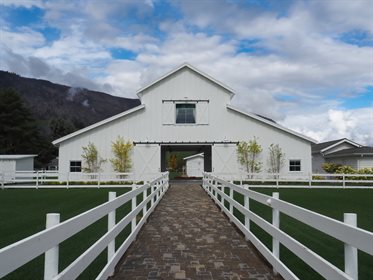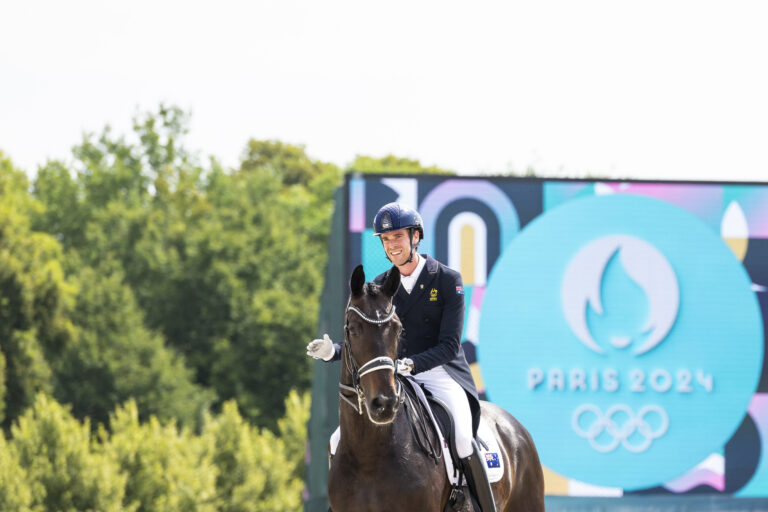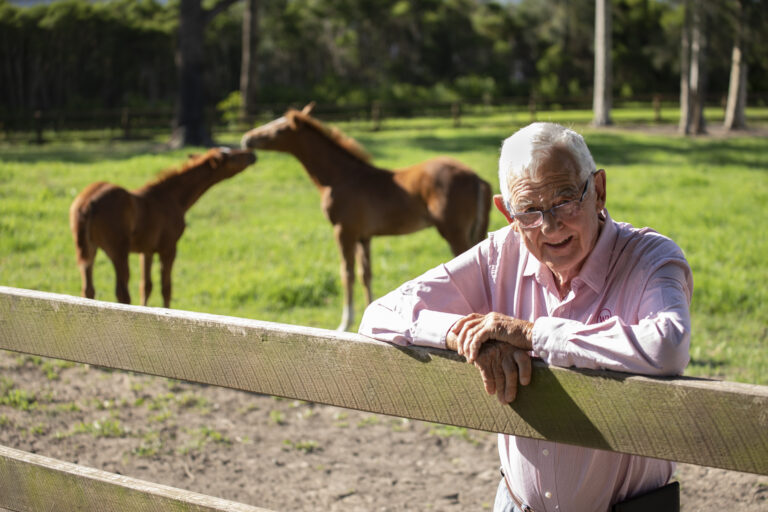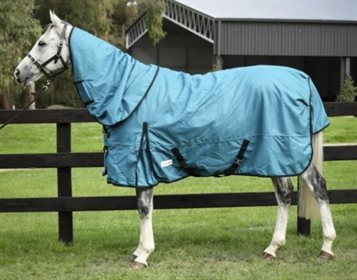Setting eyes on a beautiful, horse-safe fence gives the typical equestrian a dopamine rush!
Feel-good fencing that deters neigh-sayers
Throughout history, the crib-biter has been the scorned horse — but in the 21st century, this stereotypic behaviour doesn’t have to be a deal breaker. There are ways to manage the health of horses who crib and wood-chew, while also protecting your beautiful fencing…
By Equestrian Life
Setting eyes on a beautiful, horse-safe fence gives the typical equestrian a dopamine rush. It’s like buying a new rug or laying eyes on that first foal of the season. It’s addictive.
It’s little wonder that we invest so much in our fencing. It not only enhances the look and value of our property, but also keeps our cherished horses safe. So what happens when your treasured steed turns to chewing wood? We love our horses, but they can be heartbreakers in every sense of the word.

Quality fencing enhances the look and value of a property and also keeps our cherished horses safe.
The crimes of cribbing and chewing
Horses that crib-bite or chew wood can cause serious damage to your fencing, however in seeking the solution to the problem it’s important to understand that there are fundamental differences between the two behaviours.
Cribbing — where the horse places its upper incisors on a surface, arches its neck and pulls back while sucking in air (wind sucking) — has been a cause for concern since humans first began interacting with horses. Archaeologists in France found equine remains dating back to Palaeolithic period that showed teeth wear consistent with cribbing, while the topic first appeared in literature as early as the 16th century.
While there is still much to learn about why horses crib, it is universally considered a stereotypic behaviour. Recent studies suggest that stress is a likely factor, and some researchers have shown that when horses are allowed to perform stereotypic behaviours such as cribbing, they record a reduction in either the stress hormone cortisol or their heart rate. It is thought that rather than the horse being “naughty”, the act of cribbing is actually a coping mechanism. Perhaps not always easy to accept when there are teeth marks in your beautiful new post and rail fence.
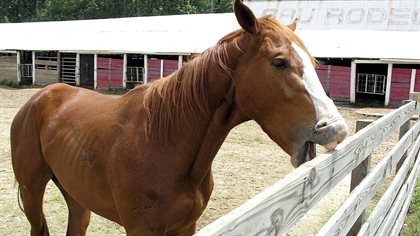
When a horse crib-bites, it places its upper incisors on a surface, arches its neck and pulls back while sucking in air (wind sucking). The behaviour can be deterimental to the horse’s health and can also damage fencing.
While in the past it was assumed horses could “learn” cribbing from others, this theory has been debunked in recent times. Instead, it’s more likely that there’s genetic link; one study found that some families of thoroughbreds have recorded a higher incidence of cribbing in comparison to the equine population at large.
There is also thought to be a link between stomach ulcers and cribbing, but whether the horse cribs to relieve the ulcers, or develops ulcers as a result of cribbing, remains unclear. It has also been found that some horses crib-bite more frequently when fed highly palatable hard feeds.
In the past, crib-biting horses have been considered unsound, with sports journalist Thomas Burgeland Johnson proclaiming in 1830 that he had “no hesitation in saying that a crib-biter is bona fide an unsound horse.” Today, crib-biting is not a deal breaker — although there are some physical issues that can arise.
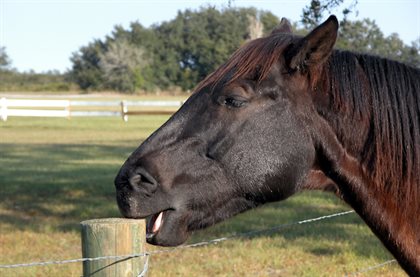
Cribbing is not a deal breaker, but the behaviour does require careful management.
Long-term crib-biters can end up with very worn front incisors, making grazing difficult, while over developed neck muscles and stylohyoid osteoarthritis (a small bone in the jaw) are also potential problems. Finally, there is also a link between cribbing and colic; much like stomach ulcers, the how and why behind this correlation remains unclear. That being said, the general consensus now is that a good horse is a good horse; and some good horses are crib-biters. The trait in itself is not enough to write them off.
So where do wood chewers enter the picture? Many horses will chew wood without wind sucking; some just like to nibble at fences.
Wood chewing can occur as a result of nutrient deficiencies, lack of forage (particularly in winter when the temperature drops and the need for forage to keep warm increases), and also boredom due to confinement or lack of socialisation. Some horses, particularly young ones, might chew when tied up. Apart from the wearing of teeth and possible splinters, wood chewing isn’t linked to the same list of physical concerns as cribbing. Less of an ingrained behavioural issue with fewer equine health consequences… but still just as much of a problem in terms of property damage!
Keeping fences beautiful
Cribbing and chewing not only leaves fencing looking shabby, thereby reducing the aesthetic appeal of your property — it shortens the life of your investment. Quality fencing should last 20 years or more, and therefore preventing damage that could shorten this lifespan is critically important.
Of course, preventing cribbing and wood chewing starts with the horse; we want our horses to be as happy and healthy as possible. You know what they say… happy horse, happy rider.
If you have a crib-biter, it’s worth checking and treating for stomach ulcers as there is anecdotal evidence that some horses with stomach ulcers stop cribbing once they’re resolved. Providing maximum time in the paddock, preferably with company, and ensuring the horse always has adequate forage available can help. If hard feed must be fed, it’s best to avoid too much sweet feed and make sure that forage is available before and while eating the hard feed. If horses must be stabled, toys can assist with boredom.

Quality fencing should last 20 years or more – if it’s not chewed!
Modern research is starting to suggest that since crib-biting is a coping mechanism, stopping it completely is not always practical; instead, it’s about minimisation through management. Some experts advocate for providing the horse with a small section of fencing covered in rubber where he’s allowed to crib-bite. This allows the ingrained crib-biter to get his fix in a limited way that doesn’t damage teeth or fencing.
Wood chewing on the other hand is something we can definitely live without. Plenty of turn out time and forage, as well as toys to prevent boredom, can help to deter a horse with a penchant for timber.
Unfortunately, keeping horses as happy and healthy as possible is not always enough to prevent property damage. While the issues surrounding cribbing in particular are complex, there is a simple way to protect your fencing against damage caused by these pesky habits. There are many different products on the market that can be used to prevent horses from chewing and crib-biting fences, however some are more effective and user friendly than others.
Premium paint products for lasting protection
Providing an attractive, mess-free alternative to sticky and unsightly anti-cribbing pastes, Stock & Noble’s Master Blend fence paint is designed to appeal to the human eye rather than the horse’s mouth. This Premium paint — which comes in black, white and clear (for natural timber fences) — is infused with Never Crib, an anti-cribbing solution that deters your equine friend from latching on.
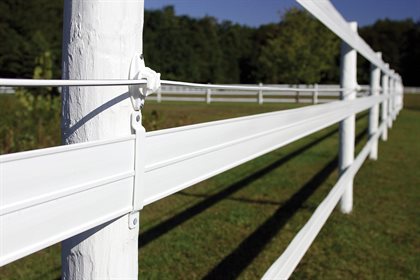
Stock & Noble’s Master Blend fence paint comes in black, white and clear (for natural timber fences).
Protecting your fencing helps to limit a horse’s chewing and crib-biting, thus helping to manage the behaviour; better for your horse, and better for your property. Even if you don’t have a crib-biter or chewer in your midst at present, a long-lasting anti-crib paint is a great way to future proof your investment and make it bite-proof from the get-go. Master Blend paints are also infused with Anti-Mould Defence and Hot Weather Technology, with the latter making it possible to apply the paint with ease — even in warmer weather.

Master Blend fence paint is easy to apply.
Through careful management and a coat of paint, you no longer need to decide between a horse with a habit and pristine fencing; you can have both. A happy horse framed by a beautiful property… now that’s what delivers the best dopamine rush of all!
You can find out more about Stock & Noble’s Master Blend fence paint here.
This article was written in conjunction with Stock & Noble.
READ THE LATEST NEWS ARTICLES HERE

